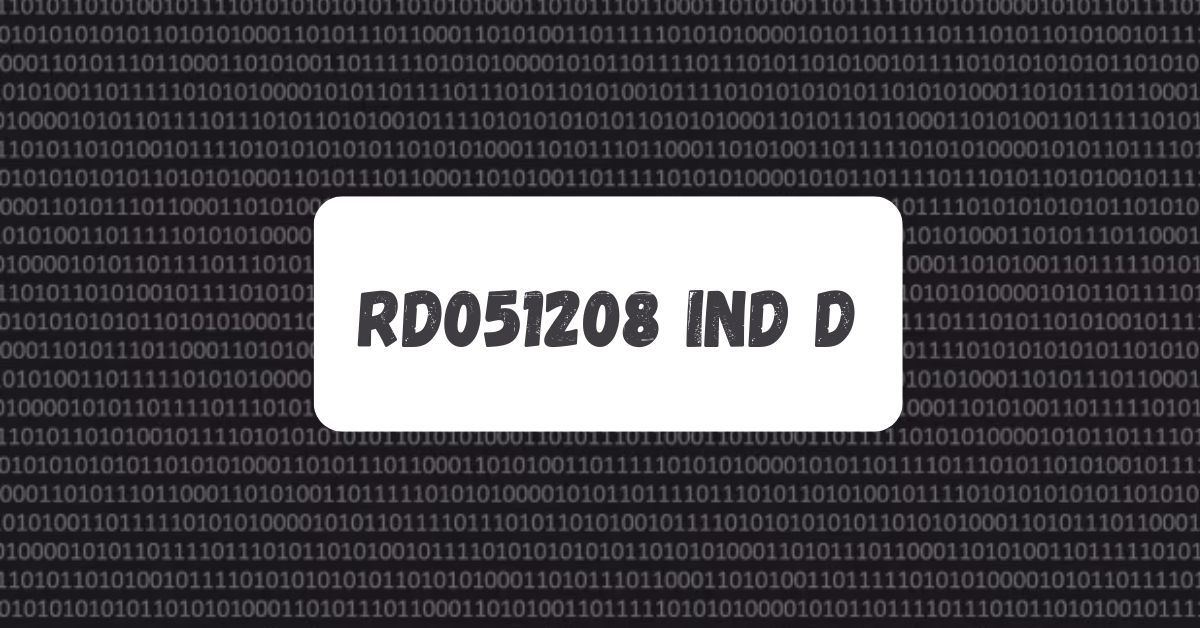Understanding rd051208 ind d
RD051208 IND D is a term that has generated curiosity among many people due to its complex nature and varied interpretations. It appears to be a technical, industrial, or possibly a coded reference used in specific fields such as research, development, pharmaceuticals, engineering, or technology. This article aims to explore all possible aspects of RD051208 IND D, including its origins, significance, applications, and potential implications in different domains.
Origins and Meaning of RD051208 IND D
To understand RD051208 IND D, one must first break it down into its components. The alphanumeric sequence suggests that it may be a classification or identifier related to a specific industry. The letters ‘IND’ could indicate an industrial or investigational designation, while ‘D’ might represent a category or version within a particular classification. The numerical sequence ‘051208’ could signify a date, a production batch, or an internal code.
Organizations, industries, and government agencies often use coded references to track projects, research studies, or inventory. If RD051208 IND D falls under such a category, it could be linked to a patent, clinical trial, production batch, or regulatory document.
Possible Industrial Applications of RD051208 IND D
Several industries use similar coded designations to maintain confidentiality, track progress, and ensure systematic documentation. Some of the key sectors where RD051208 IND D might have relevance include pharmaceuticals, engineering, research and development, and regulatory affairs.
Pharmaceutical and Medical Research Applications
One of the most probable areas where RD051208 IND D could be relevant is in pharmaceuticals. Investigational New Drug (IND) applications are common in the medical field, where pharmaceutical companies seek approval from regulatory bodies such as the FDA to test new drugs. The code RD051208 IND D might represent a specific IND application submitted on a particular date, possibly December 8, 2005 (if the numbers signify a date format). Such applications are crucial in drug development, ensuring that new medications undergo rigorous testing before entering the market.
Engineering and Industrial Manufacturing
In the engineering and industrial sectors, coded references are used to classify components, projects, or standards. RD051208 IND D might be a designation for a product model, a prototype, or a batch number related to industrial machinery, electronic devices, or construction materials. Industries dealing with complex manufacturing processes often use similar codes to manage logistics, production quality, and regulatory compliance.
Regulatory and Compliance Aspects
Regulatory bodies and compliance organizations frequently assign alphanumeric codes to track submissions, approvals, or policy changes. If RD051208 IND D falls under this category, it may be associated with an approval number for an industry-standard document, safety compliance, or certification process. Companies dealing with import-export regulations, environmental compliance, or intellectual property rights might have similar coded references for tracking legal or procedural documentation.
Technology and Digital Records Management
In the digital age, organizations use various coding systems for data management and cybersecurity. RD051208 IND D might be a system-generated code related to software development, data encryption, or an internal security protocol. If it pertains to a technology firm, it could be a reference to a software update, algorithm version, or a classified project under research.
Possible Government or Military Usage
Many government and military organizations use coded designations for classified projects, defense systems, or confidential communications. RD051208 IND D might belong to such a category, where it represents an internal code for a research initiative, a security protocol, or a restricted-access document. Defense and intelligence agencies use encrypted codes to maintain secrecy and avoid public disclosure of sensitive information.
Impact of RD051208 IND D in Various Sectors
The potential applications of RD051208 IND D in different industries indicate its possible significance. Whether it is used in pharmaceuticals, engineering, regulatory compliance, technology, or government operations, such coded references play a crucial role in maintaining systematic records, ensuring confidentiality, and streamlining operations. Understanding its context and relevance can help professionals, researchers, and industry experts decode its significance and utilize it effectively.
Challenges in Interpreting Coded Designations
Interpreting codes like RD051208 IND D presents several challenges. Without proper documentation or an authoritative source, it is difficult to ascertain the exact meaning and application of such a code. Organizations that rely on coded references often maintain internal databases where these designations are explained. However, for the general public or external entities, decoding such references requires deep industry knowledge and access to relevant documentation.
Another challenge lies in the evolving nature of coded classifications. Companies and industries frequently update their coding systems, making older references obsolete or difficult to track. Without contextual clarity, it becomes challenging to determine whether RD051208 IND D is still in active use or has been replaced by a more recent classification.
Future Implications and Developments
The use of coded identifiers like RD051208 IND D will likely continue to grow across industries. With advancements in artificial intelligence, blockchain technology, and digital security, organizations are finding more efficient ways to manage and classify their data. Future trends may involve enhanced transparency, where companies provide more accessible explanations for coded references without compromising confidentiality.
In pharmaceuticals and medical research, investigational drug applications (INDs) will remain crucial in bringing new treatments to the market. If RD051208 IND D relates to such an application, tracking its progress could provide insights into groundbreaking medical advancements. Similarly, in engineering and industrial sectors, better classification systems will improve efficiency and regulatory compliance.
Technology firms will likely integrate advanced tracking mechanisms to manage software versions, security updates, and intellectual property. If RD051208 IND D pertains to a digital system, its role in data security and software development could be significant.
Conclusion
RD051208 IND D is a coded reference that holds potential significance in various industries, including pharmaceuticals, engineering, regulatory compliance, technology, and government operations. While its exact meaning remains uncertain, analyzing its structure and possible applications provides valuable insights into how industries use coded designations for systematic documentation and operational efficiency.
Understanding such references requires industry knowledge, contextual clarity, and access to relevant documentation. As businesses and organizations continue to develop and evolve, the use of alphanumeric codes like RD051208 IND D will remain a crucial aspect of data management, confidentiality, and regulatory compliance. Future advancements in technology and transparency may lead to better understanding and utilization of such coded identifiers in various fields.







